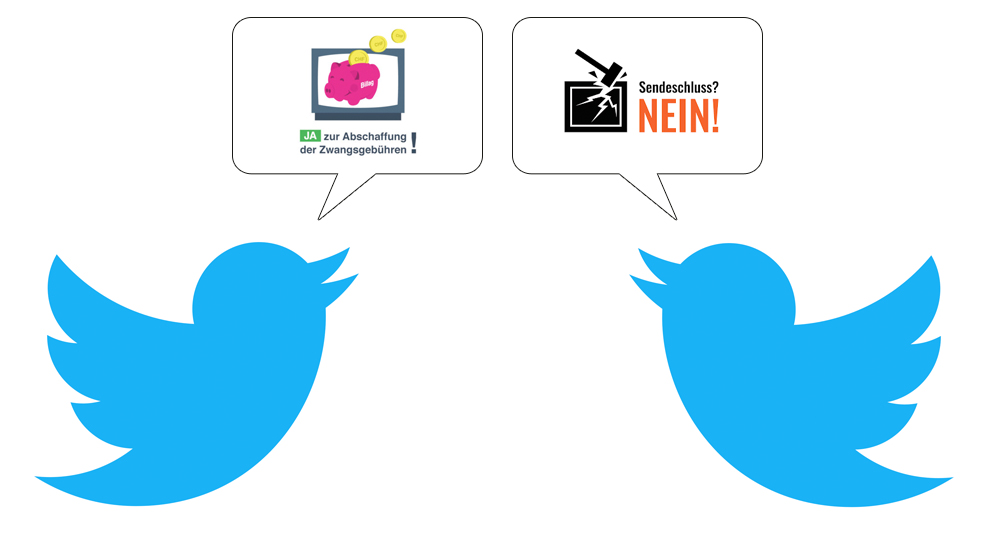The No Billag referendum campaign on Twitter takes place in filter bubbles
The SonntagsZeitung has analyzed the referendum campaign on the No Billag initiative on Twitter. It shows that the majority of the camps remain among themselves - but the supporters are more interested in the opinion of the opposing side.

The social media campaign for the No Billag initiative is more bitter than ever before. SonntagsZeitung analyzed 60,000 tweets on the topic published between September 2017 and January 2018.
This shows that there is less evidence of a real debate. This means that opponents and supporters are in the information filter bubbles typical of social media - in other words, the majority keep to themselves and only read what suits their opinion.
The 46 most popular accounts of both camps
For the analysis, the 46 most popular Twitter accounts of No Billag supporters and opponents were identified in collaboration with the statistics blog Politan.
The top account followed by the most No Billag opponents is the official channel of the No committee @NoSendeschluss, followed by the Twitter account of SP National Councilor Jacqueline Badran, the channel of Operation Libero and that of Viktor Giacobbo. This is followed by the accounts of Jonas Projer, Arthur Honegger and Sandro Brotz, three "directly affected" SRF representatives. Seventh to tenth place are occupied by media expert Vinzenz Wyss, political scientist Claude Longchamp and political consultant Mark Balsiger.
Most supporters follow the account of the Yes Committee @No-Billag, followed by the anonymous account @person_tw and the account Media Freedom @srgwatch. Zurich Cantonal Councilor René Truninger ranks 4th, SVP National Councilor Claudio Zanetti 5th, followed by the accounts @iostatus, @LahorJarklin, BaZ journalist Dominik Feusi @feusl, @S3ifenblase and @FlorianSchwab.
Pro camp follows more opponents than vice versa
The overview shows that more supporters follow the most popular accounts of the opponents than vice versa. Only the official No Billag account seems to be under the observation of the No Billag opponents - it is followed by half as many opponents as supporters. Across all accounts, supporters follow four times more opponents' accounts than vice versa.
No surprise for SVP National Councilor Claudio Zanetti, as he explained to the SonntagsZeitung. The No camp is connected to the "left mainstream" and in this "biotope" it is important that everyone follows the same narrative. As an example, he adds how the musicians and artists had initially held back and were then "trimmed to the course by peer pressure".
David against Goliath
Online campaign expert Daniel Graf sees things differently. The openness of the supporters was born out of necessity - a compulsion to be able to plow new target groups. The opponents, on the other hand, do not want to get involved in a debate so as not to attract additional attention to the proponents' side.
And Graf points to another indication of this David-versus-Goliath balance of power: While on the opposing side the most influential accounts belonged to celebrities and opinion makers, the other side consisted almost exclusively of underdogs whose common trademark was provocation and who hardly played a role in the rest of the Swiss social media universe.
Common denominators of both camps
Despite the many differences, there is also a common intersection of supporters and opponents. The followers of the 46 most popular pro and con accounts follow various "neutral" accounts in similar numbers. The most popular in both camps is @politnetzCH, followed by the account of SonntagsZeitung, and SP politician Felix Hoesch. Also highly popular: the account of the Switzerland on Sunday and its editor-in-chief Patrik Müller. CVP National Councilor Gerhard Pfister, AZ Media TV Editor-in-Chief Markus Gilli and the business association Economiesuisse are also followed by roughly equal numbers of supporters and opponents. (hae)








